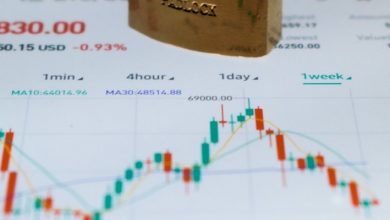Crypto Market Cycles: Timing Your Entry and Exit Points

- Understanding the Psychology Behind Crypto Market Cycles
- Analyzing Historical Data to Predict Market Trends
- Strategies for Identifying Entry Points in a Volatile Market
- The Importance of Setting Exit Points to Secure Profits
- Tools and Indicators to Help Time Your Trades Effectively
- Navigating Bull and Bear Markets: A Guide for Crypto Investors
Understanding the Psychology Behind Crypto Market Cycles
Understanding the psychology behind crypto market cycles is essential for investors looking to time their entry and exit points effectively. Market cycles in the cryptocurrency space are driven by a combination of factors, including investor sentiment, market trends, and external events.
Investors often experience emotions such as fear, greed, and FOMO (fear of missing out) during different phases of a market cycle. These emotions can lead to irrational decision-making, causing prices to fluctuate wildly. By understanding these psychological factors, investors can better anticipate market movements and make more informed trading decisions.
One common psychological phenomenon in crypto market cycles is the herd mentality, where investors follow the crowd without conducting their own research. This behavior can lead to price bubbles and subsequent crashes as market sentiment shifts. It is essential for investors to remain objective and not get swept up in the hype surrounding certain assets.
Another important aspect of understanding market cycles is recognizing the role of institutional investors and whales in the market. These entities have the power to influence prices through large trades and coordinated buying or selling. By monitoring their activities, retail investors can gain insights into potential market movements.
Overall, by delving into the psychology behind crypto market cycles, investors can gain a deeper understanding of market dynamics and make more strategic investment decisions. It is crucial to remain disciplined, conduct thorough research, and stay informed about the latest developments in the cryptocurrency space to navigate market cycles successfully.
Analyzing Historical Data to Predict Market Trends
When it comes to predicting market trends in the crypto industry, analyzing historical data can be a valuable tool. By looking at past market cycles, investors can gain insights into potential future patterns and make more informed decisions about when to enter or exit the market.
One key aspect of analyzing historical data is identifying market cycles. These cycles typically consist of four phases: accumulation, uptrend, distribution, and downtrend. By studying how these phases have played out in the past, investors can better anticipate when the market may be reaching a peak or bottom, helping them time their entry and exit points more effectively.
Another important factor to consider when analyzing historical data is market sentiment. Sentiment analysis involves tracking the overall mood of market participants, which can provide valuable clues about where the market may be headed next. By paying attention to sentiment indicators such as social media trends and news headlines, investors can gauge the level of fear or greed in the market and adjust their strategies accordingly.
Strategies for Identifying Entry Points in a Volatile Market
One of the key aspects of successfully navigating the volatile crypto market cycles is being able to identify entry points at opportune times. There are several strategies that can be employed to help you make informed decisions when it comes to entering the market. By utilizing these strategies, you can increase your chances of maximizing profits and minimizing losses.
One effective strategy for identifying entry points in a volatile market is to pay close attention to market trends and patterns. By analyzing historical data and chart patterns, you can gain valuable insights into when it might be a good time to enter the market. Look for signs of price reversals or breakouts that could indicate a potential entry point.
Another useful strategy is to set specific entry criteria based on your trading strategy and risk tolerance. Define clear parameters for when you will enter the market, such as a certain price level or technical indicator confirming a trend reversal. By sticking to your predetermined criteria, you can avoid making impulsive decisions based on emotions.
Additionally, it can be helpful to utilize technical analysis tools and indicators to identify potential entry points. Tools such as moving averages, relative strength index (RSI), and Fibonacci retracement levels can provide valuable insights into market trends and potential entry points. By incorporating these tools into your analysis, you can make more informed decisions about when to enter the market.
Overall, successfully navigating volatile market cycles requires a combination of careful analysis, strategic planning, and disciplined execution. By following these strategies for identifying entry points, you can position yourself for success in the ever-changing crypto market.
The Importance of Setting Exit Points to Secure Profits
Setting exit points is crucial when it comes to securing profits in the volatile crypto market cycles. Knowing when to take your gains and walk away can make the difference between success and failure in your trading endeavors. By establishing clear exit points ahead of time, you can avoid making emotional decisions based on market fluctuations.
One effective strategy is to use technical analysis to identify key resistance levels where you can set your exit points. These levels act as barriers that the price of a cryptocurrency must break through in order to continue its upward trend. By selling when the price reaches these resistance levels, you can lock in profits and protect your investment.
Another important factor to consider when setting exit points is to take into account your risk tolerance and investment goals. If you are a conservative investor, you may choose to set tighter exit points to secure smaller profits more frequently. On the other hand, if you are comfortable with taking on more risk, you may opt for wider exit points to allow for larger potential gains.
It is also essential to regularly review and adjust your exit points as market conditions change. By staying informed and adapting to new developments, you can ensure that your profits are maximized and your losses are minimized. Remember, the key to successful trading is not just knowing when to enter the market, but also when to exit to secure your profits.
Tools and Indicators to Help Time Your Trades Effectively
When it comes to navigating the volatile waters of the crypto market cycles, having the right tools and indicators can make all the difference in timing your trades effectively. By leveraging these resources, you can increase the likelihood of entering and exiting positions at opportune moments, maximizing your potential profits.
One key tool that many traders rely on is technical analysis. This involves studying historical price movements and using various indicators to forecast future price action. Some popular technical indicators include moving averages, Relative Strength Index (RSI), and Bollinger Bands. By incorporating these tools into your trading strategy, you can gain valuable insights into market trends and potential entry and exit points.
Another valuable resource for timing your trades is sentiment analysis. This involves gauging the overall market sentiment towards a particular cryptocurrency, which can help you anticipate shifts in market direction. By monitoring social media, news articles, and online forums, you can stay informed about market sentiment and adjust your trading strategy accordingly.
In addition to technical and sentiment analysis, setting clear entry and exit points based on your risk tolerance and investment goals is essential for successful trading. Establishing stop-loss orders to limit potential losses and take-profit orders to secure profits can help you mitigate risk and maximize returns. By adhering to a disciplined trading plan, you can avoid emotional decision-making and stay focused on your long-term objectives.
Navigating Bull and Bear Markets: A Guide for Crypto Investors
Navigating through bull and bear markets in the crypto world can be a daunting task for investors. Understanding the dynamics of these market cycles is crucial for making informed decisions on when to enter or exit the market. In a bull market, prices are on the rise, and investor sentiment is generally positive. This is the time when investors are optimistic about the future of a particular cryptocurrency and are more willing to buy. On the other hand, in a bear market, prices are falling, and investor sentiment is negative. This is when investors are more cautious and may consider selling their assets to avoid further losses.
During a bull market, it’s essential to keep a close eye on market trends and indicators to determine when the market may be reaching its peak. This is the time when it may be wise to start considering taking profits or securing your investments. On the other hand, during a bear market, it’s crucial to have a plan in place to protect your investments and minimize losses. This may involve setting stop-loss orders or diversifying your portfolio to reduce risk.
Timing your entry and exit points in the crypto market requires a combination of technical analysis, market research, and risk management. It’s essential to stay informed about market developments, regulatory changes, and technological advancements that could impact the value of cryptocurrencies. By staying educated and proactive, investors can navigate through bull and bear markets with more confidence and make better-informed decisions about their investments.



